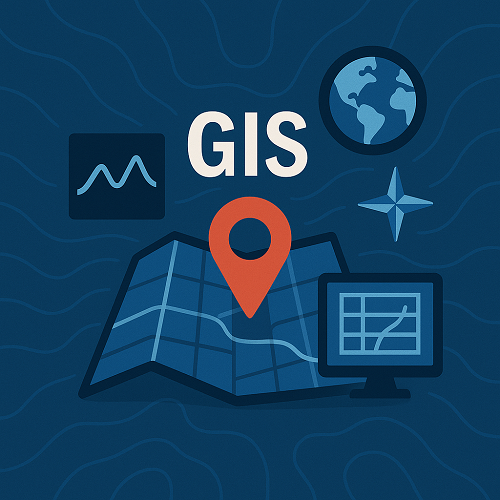TL;DR
- AI-driven spatial analytics are revolutionizing how organizations interpret location data.
- Esri remains the market leader, expanding GIS tools for urban planning and sustainability.
- Emerging trends integrate GIS with space exploration and remote sensing.
- Real-time data processing and predictive modeling enhance decision accuracy.
- Businesses are leveraging GIS for smarter infrastructure and climate resilience planning.
What’s New Right Now
In 2025, the Geospatial Information System (GIS) landscape is being reshaped by advanced artificial intelligence integrations and data automation. Industry leader Esri continues to drive innovation with improvements to its ArcGIS suite, emphasizing predictive spatial analytics, 3D mapping, and real-time geospatial dashboards. AI-assisted classification of satellite imagery, automated map generation, and deep learning for environmental analysis are redefining operational efficiencies across industries. Trends from agencies like NASA Earthdata further highlight GIS’s expanding role in supporting planetary exploration and climate prediction models.
Why It Matters
For business leaders, modern GIS technology provides a competitive edge in site selection, logistics optimization, and infrastructure management. Urban planners use spatial data to design sustainable cities, while emergency services leverage geospatial models for disaster risk reduction. Technical stakeholders benefit from AI-enhanced accuracy, improved automation, and cloud scalability, lowering operational costs and enabling faster decision-making.
Deep Dive: Trends Shaping GIS in 2025
1. AI‑Enhanced Spatial Intelligence
Machine learning models now process petabytes of remote sensing data with unprecedented precision. Algorithms detect changes in vegetation, urban expansion, and water systems, helping analysts predict environmental impacts before they occur. This reduces manual labor and enhances spatial pattern recognition accuracy.
2. Real-Time Urban Modeling
Smart city initiatives rely heavily on dynamic GIS dashboards that combine IoT sensors with spatial maps. Planners visualize traffic flows, energy consumption, and population densities to forecast needs and mitigate pressure on city infrastructure.
3. Space and Earth Observation Integration
GIS applications now extend beyond Earth. Real-time mapping supports planetary exploration missions by integrating terrain data from Mars and lunar sensors—continuing NASA’s and ESA’s push toward digital space cartography. Insights gained from these efforts feed back into Earth systems management and sustainability strategies.
Comparison of Key Approaches
| Approach | Primary Use | Strength | Challenge |
|---|---|---|---|
| Traditional GIS | Static mapping & visualization | Reliable spatial accuracy | Limited automation |
| AI‑Integrated GIS | Predictive modeling & pattern analysis | High efficiency & adaptability | Requires quality training data |
| Cloud‑Based GIS | Scalable, collaborative platforms | Accessibility & cost savings | Data governance concerns |
| Space‑Enabled GIS | Interplanetary data & Earth observation | High-resolution insights | Complex data integration |
Mini Case Study: Smart Water Resource Management
Problem: A regional utility provider faced recurring droughts and inefficient reservoir allocation. Manual monitoring was too slow to support timely interventions.
Approach: The organization implemented an AI-integrated GIS platform powered by Esri ArcGIS and deep learning models. By correlating rainfall data, satellite imagery, and consumption patterns, the team developed predictive maps to forecast supply vulnerabilities.
Outcome: Within one year, water distribution efficiency improved by 23%, and unaccounted water loss dropped by 15%. The predictive pipeline allowed proactive regulation of water resources and informed future infrastructure investments.
Implementation Checklist
- Assess current GIS maturity and identify potential AI use cases.
- Consolidate spatial datasets from multiple departments and validate data quality.
- Select a scalable GIS platform (e.g., cloud-based Esri or open-source QGIS solutions).
- Integrate machine learning frameworks for pattern recognition and automation.
- Train staff in spatial analytics and data ethics best practices.
- Set up continuous monitoring dashboards for performance and outcome tracking.
Frequently Asked Questions
1. What is the biggest GIS trend in 2025?
AI-driven spatial analytics and real-time data integration are leading trends, shaping predictive planning and automation.
2. How is GIS used in business decision-making?
GIS supports strategic planning by visualizing demographic, economic, and environmental variables to optimize investments and operations.
3. Are AI-powered GIS systems difficult to implement?
Implementation complexity depends on data readiness. Cloud solutions and APIs have made integration more accessible for non-specialists.
4. Can GIS contribute to sustainability?
Yes. GIS enables precision agriculture, climate risk mapping, and renewable energy planning—vital tools for sustainability goals.
5. Which industries benefit most from advancements in GIS?
Urban planning, transportation, utilities, natural resource management, and defense sectors gain the most value from enhanced geospatial intelligence.
6. What skills are needed for next-generation GIS analysts?
Analysts require geospatial analytics knowledge, AI literacy, and experience in data science platforms such as Python or R integrated with GIS tools.
Conclusion
As GIS technologies evolve through AI, automation, and spatial computing, their impact reaches every sector—from managing cities to exploring new worlds. Organizations that invest early in intelligent geospatial systems position themselves for greater resilience and innovation. To learn more about how your enterprise can adopt cutting-edge mapping solutions, explore our GIS services today.
